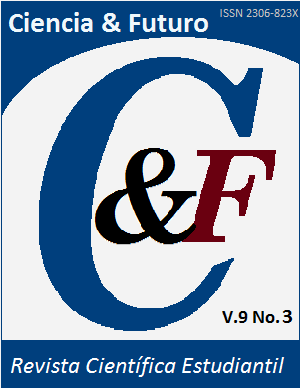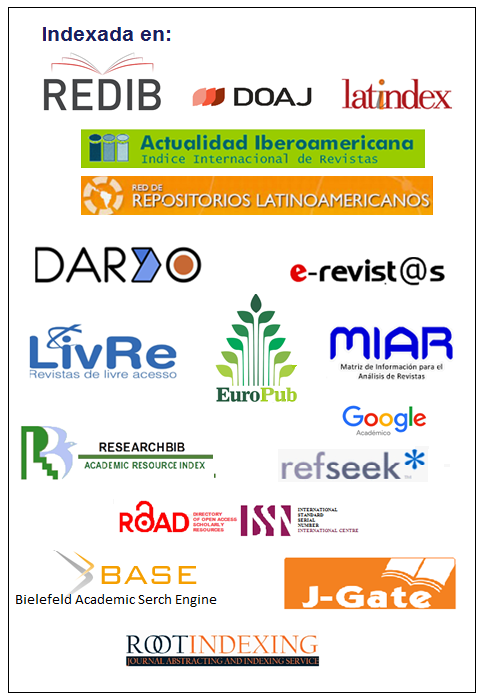Incidence 0f the friction-stir welding process parameters of aluminum alloy
Keywords:
microstructures, friction stirring, conical pin, affected thermo-mechanical zone.Abstract
Hardness and the microstructural variations were established in an AA 1050 series aluminum alloy subjected to friction stir weld. The design of the tool used consisted of a concave shoulder and threaded conical pin combination. Sheets metals were perpendicularly cut; lamination direction 180 mm long and 80 mm wide with 5 mm thickness, they were joined in series of two sheets along by drawing 170 mm weld seams. From a small grains structure and a continuous network of fine particles in α-phase matrix with equiaxial grains, after welding, the affected thermo-mechanical zone shows a reorientation, with some recrystallization degree and the presence of re-precipitated eutectic silicon particles in the affected thermal zone.Downloads
References
ARBEGAST, W. 2003. Constitutive analysis, modeling and simulation, In: JIN, Z.; BEAUDOIN, A.; BIELER, T. A. & RADHAKRISHNAN. B. (editors). Hot deformation of aluminum alloys III. John Wiley & Sons, Warrendale. 313 p.
CARRASCO, J.; BERDUGO, I.; OSPINA, R. & UNFRIED, J. 2013. Optimización del diseño y fabricación de herramienta con pin cónico roscado para soldadura por fricción-agitación. Revista Visión Electrónica 7(2): 135-144.
DICKERSON, T.; SHI, Q. & SHERCLIFF, H. 2003. Heat flow into friction stir welding tools. In: 4th International Symposium on Friction Stir Welding. Park City, Utah, 14-16.
GALLAIS, C.; DENQUIN, A.; BRECHET, Y. & LAPASSET, G. 2008. Precipitation microstructures in an AA6065 aluminum alloy after friction stir welding: Characterization and modelling. Materials Science and Engineering, A 496(21): 77-89.
JATA, K.; SANCARAN, K. & RUSCHAV, J. 2000. Friction stir welding effect on microstructure and fatigue of aluminum alloy 7050 t-7451. Metallurgical and Materials Transactions A, 31A(7): 2181-2192.
LAKSHMINARAYANAN, A.; ANNAMALAI, V. & ELANGOVAN, K. 2015. Identification of optimum friction stir spot welding process parameters controlling the properties of low carbon automotive steel joints. Journal of Materials Research and Technology 4(3): 262-272.
MAHMOUD, T. & KHALIFA, T. 2014. Microstructural and mechanical characteristics of aluminum alloy AA5754 friction stir spot welds. Journal of Materials Engineering and Performance 23(3): 898-905.
MIJAJLOVIĆ, M. 2011. Mathematical model for analytical estimation of generated heat during friction stir welding. Part 1. Journal of Balkan Tribological Association 17(2): 179-191.
MIROSLAV, M.; NENAD, P.; SLOBODAN, J.; DRAGAN, J. & MIODRAG, M. 2012. Experimental studies of parameters affecting the heat generation in friction stir welding process. Thermal Science 16(2): S405-S417.
NANDAN, R.; DEBROY, T. & BHADESHIA, H. 2008. Recent advances in friction stir welding process, weldment structure and properties. Progress in Materials Science 53(20): 980-1023.
PAIDAR, M.; KHODABANDEH, A.; NAJAFI, H. & SABOUR, A. 2014. Effects of the tool rotational speed and shoulder penetration depth on mechanical properties and failure modes of friction stir spot welds of aluminum 2024-T3 Sheets. Journal of Mechanical Science and Technology 28(12): 123-131.
PEEL, M.; STEUWER, A.; PREUSS, M. & WITHERS, P. 2003. Microstructure, mechanical properties and residual stresses as a function of welding speed in aluminum AA5083 friction stir welds. Acta Materialia 51(16): 4791-4801.
RAJAMANICKAM, N.; BALUSAMY, V.; REDDY, G. & NATARAJAN, K. 2009. Effect of process parameters on thermal history and mechanical properties of friction stir welds. Mater. Design 30(6): 2726-2731.
RIAHI, M. & NAZARI, H. 2010. Analysis of transient temperature and residual thermal stresses in friction stir welding of aluminum alloy 6061-T6 via numerical simulation. Int. J. Advanced Manuf. Technol. 55(15): 143-152.
SATHIYA, P.; ARAVINDAN, S. & NOORUL, A. 2005. Mechanical and metallurgical properties of friction welded AISI 304 austenitic stainless steel [J]. Int J Adv Manufact Technol 26(10): 505-511.
SONG, M. & KOVACEVIC, R. 2003. Thermal modelling of friction stir welding in a moving coordinate system and its validation. Int. J. Machine Tools & Manuf 43(11): 605-615.
STEUWER, A.; PEEL, M. & WITHERS, P. 2006. Dissimilar friction stir welds in 5083-6082: The effect of process parameters on residual stress. Materials Science and Engineering A 441(1-2): 187-196.
SUTTON, M.; REYNOLDS, P.; WANG, D. & HUBBARD, C. 2002. Study of residual stresses and microstructure in 2024-T3 aluminum friction stir butt welds. Journal of Engineering Materials and Technology 124(2): 215-225.
SHI, Q.; DICKERSON, T. & SHERCLIFF, H. 2003. Modelo termo-mecánico por EF de la soldadura por fricción agitación de AL2024 incluyendo la carga axial sobre la herramienta. En: 4to Simposio Internacional de Soldadura por Fricción Agitación.
VELJIĆ, D. 2012. A coupled thermo-mechanical model of friction stir welding. Thermal Science 16(2): 527-534.
Published
How to Cite
Issue
Section
Esta obra está bajo una Licencia Creative Commons Reconocimiento-NoComercial 4.0 Internacional
La Revista Ciencia & Futuro es una revista de acceso abierto, todo el contenido está disponible gratuitamente sin cargo para el usuario o su institución. Los usuarios pueden leer, descargar, copiar, distribuir, imprimir, buscar o vincular los textos completos de los artículos, o utilizarlos para cualquier otro fin lícito, sin pedir permiso previo al editor o al autor. Todo lo anterior, de acuerdo con la definición de BOAI de acceso abierto.
Los autores que publican en esta revista están de acuerdo con los siguientes términos: Licencia Creative Commons Atribución-NoComercial permite que el beneficiario de la licencia tenga el derecho de copiar, distribuir, exhibir y representar la obra y hacer obras derivadas para fines no comerciales siempre y cuando reconozca y cite la obra de la forma especificada por el autor o el licenciante. Los autores pueden establecer por separado acuerdos adicionales para la distribución no exclusiva de la versión de la obra publicada en la revista (por ejemplo, situarlo en un repositorio institucional o publicarlo en un libro), con un reconocimiento de su publicación inicial en esta revista. Se permite y se anima a los autores a difundir sus trabajos electrónicamente (por ejemplo, en repositorios institucionales o en su propio sitio web) antes y durante el proceso de envío, ya que puede dar lugar a intercambios productivos, así como a una citación más temprana y mayor de los trabajos publicados (Véase The Effect of Open Access) (en inglés). Lo anterior debe realizarse siempre sobre el artículo ya publicado por Ciencia & Futuro.
Los autores mantienen el control sobre la integridad de sus trabajos y el derecho a ser adecuadamente reconocidos y citados.
A los editores se les otorgan derechos no exclusivos para publicar y distribuir.




